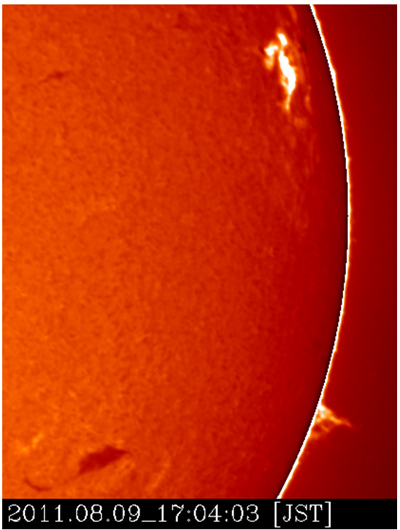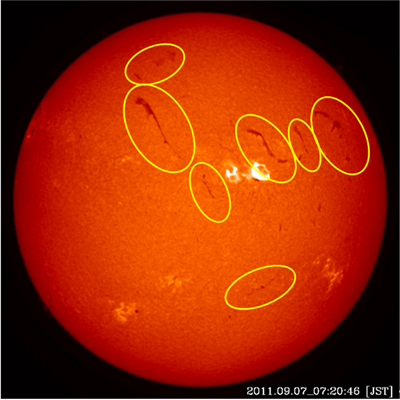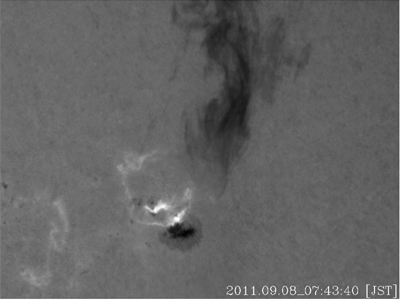September 16, 2011
Between 2008 – 2009, solar activity was at its lowest for 100 years, but recently a new cycle of solar activity has started (cycle 24) and large flares (explosions in the solar atmosphere) have started to appear again. This rise in solar activity is being monitored at Hida observatory and Kwasan observatory, Graduate School of Science, Kyoto University, where the large flares that occurred on the 9th August and the 7th and 8th of September 2011 (Japanese Standard Time; JST) were observed.
To have so many large flares in such a short period of time is very rare. Also, having just had an unusually long period of solar inactivity, the data obtained by observing these recent flares may be very important in understanding the long timescale variations of the Sun. Moreover, when large flares occur, they are often associated with shock waves and ejections of large amounts of plasma into interplanetary space. These phenomena can interact with the Earth’s magnetosphere creating magnetic storms and aurorae near the magnetic poles, as well as impacting on our everyday lives by, amongst other effects, damaging man-made satellites. To try to reduce any potential damage from violent solar activity, the study of the plasma and magnetic field surrounding the Earth to allow forecasting of this “space weather” is very important. Therefore, research relating to large flares is very important in relation to space weather forecasting.
A shock wave in the solar corona, as well as the first observation in the world of simultaneous filament and prominence oscillations were observed in association with the large flare that occurred on 9th August 2011. The large flare that occurred on 7th September showed multiple filament oscillations (7 oscillating filaments found). There is the distinct possibility that filaments that oscillate in this way are susceptible to eruption; therefore detailed analysis of this data is important. The flare on September 8th was observed using a new optical system developed by Hida observatory in collaboration with Solar-Terrestrial Environment Laboratory (STELab) of Nagoya University. This instrument has the fastest time cadence observations of the sun in the world allowing the very short timescale changes in a flare to be resolved.
These observations were performed by Dr. Takako T. Ishii (Assistant teaching staff), Dr. Ayumi Asai (Unit of Synergetic Studies of Space, Assistant Professor), Prof. Kiyoshi Ichimoto and Prof. Kazunari Shibata (Observatory director), as well as the other members of this group.

- Fig 1: Image showing region of large flare on 9th August 2011 17:00 JST. The edge of the solar disk can be seen. The flare is the bright region in the top right of the image. There is a filament in the bottom left of the image and a prominence in the bottom right of the image. The flare created a shockwave in the solar atmosphere which hit both the filament and the prominence, as a result driving their oscillation. (Hida Observatory)

- Fig 2: Image of full solar disk on 7th September 2011 07:00 JST. The flare region is the bright region just right of the disk centre. The long, thin, dark regions are filaments. The 7 filaments, highlighted with yellow ellipses, were found to oscillate as a result of the flare. (Hida Observatory)

- Fig. 3: Image showing region of large flare on 8th September 2011 07:30 JST. There is a sunspot in the bottom part of the figure. The bright region just above this sunspot is the flare. The dark cloudlike structure is a filament eruption, erupting toward the top-right of the image. (Hida Observatory & STELab. Nagoya University)

